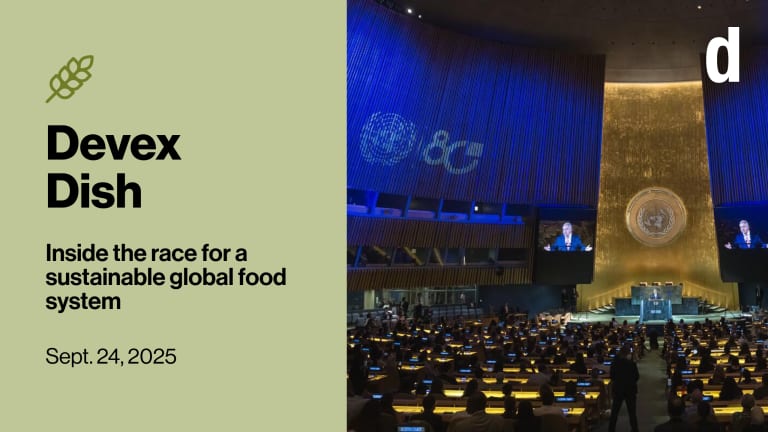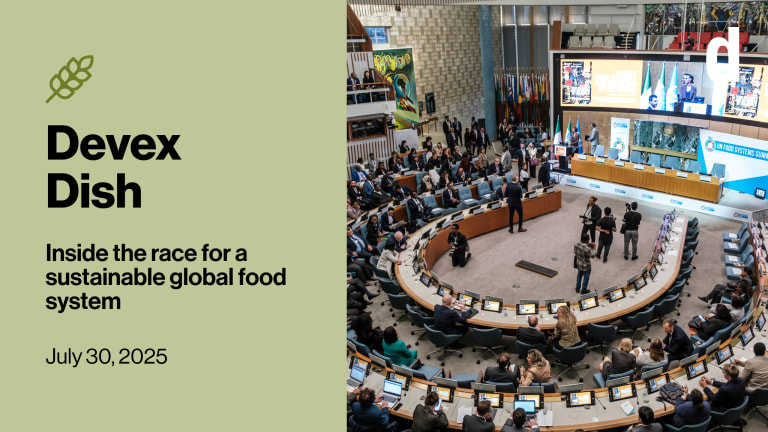
BRUSSELS — With some form of malnutrition affecting 1 in 3 people and costing an estimated $3.5 trillion each year, the United Nations’ agriculture and health agencies have released guidance to countries on what constitutes a sustainable, healthy diet.
Their guiding principles, out this week following an expert consultation in July, offer a roadmap for policymakers, Nancy Aburto, deputy director in the nutrition and food systems division of the U.N. Food and Agriculture Organization, told Devex on Tuesday in Brussels.
“We put together a list of concepts of what it means to reach, without exceeding, nutritional needs in a diet, and at the same time reducing pressure and impact on the environment, and also respecting cultural aspects of food and nutrition,” Aburto said.
Acute hunger hits 113 million people, but data gaps remain
Food crises in 2018 were driven by conflict, climate change, and economic shocks, according to the "Global Report on Food Crises" — conditions that aren't expected to abate this year.
The principles include: favoring breastfeeding; a variety of unprocessed or minimally processed foods; limiting greenhouse gas emissions; minimizing use of packaging, and food waste; and avoiding time-intensive buying and preparation of food, which can adversely affect women.
Aburto said the document does not stipulate steps as specific as a sugar tax, because that “may not be the solution in a particular country.”
“Because this is global, this is the type of document that can be taken and then [policymakers] look at this and you can determine for your particular context would the sugar tax, for example, be the priority action,” she said.
The principles are among a slew of information released around World Food Day on Oct. 16. On Tuesday, FAO released its State of Food and Agriculture report, which found “around 14% of food produced is lost from the post-harvest stage up to, but excluding, the retail stage.”
UNICEF also highlighted issues surrounding nutrition and food systems in its annual “State of the World’s Children 2019” report, which depicts an alarming situation of child stunting and wasting worldwide: 149 million stunted children under 5, and almost 50 million suffering from wasting.
It’s the first time in 20 years the U.N. program is focusing on the issue of malnutrition in its annual report. Rene Galera, nutrition specialist for UNICEF in the Philippines, told Devex the focus is important given the slow decline in stunting globally, little change on wasting prevalence — except for a few countries like the Philippines — and the “gradual rise of overweight and obesity,” which has become an expanded focus of the organization in its latest nutrition strategy.
Explore Devex’s dedicated news section with regular, editorially independent coverage of the challenges, solutions, and innovations in nutrition, with financial support from our partner DSM.
Forty million children over 5 years old are overweight globally, according to UNICEF data. And since 2000, the proportion of children ages 5 to 19 who are overweight has risen from 1 in 10 to almost 1 in 5. Data further shows that 42% of adolescents who attend school drink carbonated soft drinks at least once a day and that 46% consume fast food once a week.
“Previously we did focus on stunting and wasting and maternal nutrition, but now we are also more closely looking at the issue of overweight and obesity. And we really have to work with other partners. For example, WHO, FAO, and WFP, because UNICEF cannot do it alone and we do have each of our mandates. But maybe if we work together, then that's when we can really make a stop to that increase in prevalence rate for overweight and obesity,” Galera said.
He said interventions to address stunting and wasting are similar to those for overweight and obesity. For instance, breastfeeding.
“If you actually consider it, breast milk substitutes or infant formula has a lot of sugar. So if we prevent that from happening, [by] ensuring that babies actually get the right food during the first months of life, then we can actually prevent overweight and obesity, especially in less than six months,” he said.
There are several challenges, however, from “too much marketing” of unhealthy food, and limited information to guide parents in their food choices. Another challenge is ensuring food systems are working, to ensure children and their families are able to lead healthy diets.
“Because if you want to make sure that food is healthy and affordable, we have to take a look at each of these elements: Are we providing ample support to the growers so that they can produce diverse crops, for example, not just focused on rice? Are we looking at the middle man so that they don't top up too much cost to drive the costs forward? Or do they also provide the right price to the growers? Are you also looking at advertisers, which can influence the choices? You could also look at points of sale because that's where placements of advertisements or even markups can happen,” he said.
In their 2019 global hunger index, released Tuesday, Concern Worldwide and Welthungerhilfe highlighted the impact of climate change on food systems and its effect on hunger and undernutrition. The report reveals 43 countries having “serious” levels of hunger, with the level of hunger in the Central African Republic “extremely alarming.”
With the Committee on World Food Security meeting this week in Rome, the Global Agriculture and Food Security Program released its investment case, aiming to generate $1.5 billion between 2020 and 2025 to fight hunger, malnutrition, and poverty. The GAFSP replenishment conference will be held in Germany in June 2020.
This focus area, powered by DSM, is exploring innovative solutions to improve nutrition, tackle malnutrition, and influence policies and funding. Visit the Focus on: Improving Nutrition page for more.









